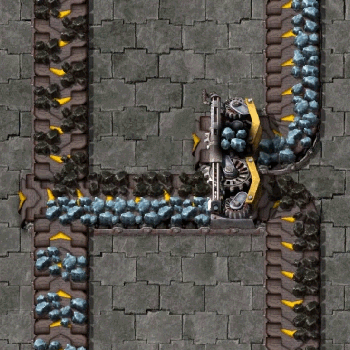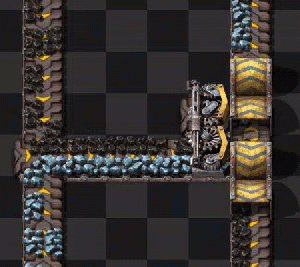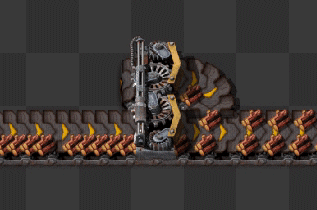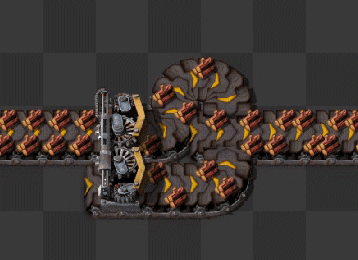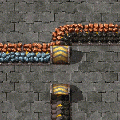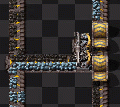User:Fried biter/workspace: Difference between revisions
Fried biter (talk | contribs) m [WIP] Copied Belt transport system from Special:PermanentLink/165434 to translate |
Fried biter (talk | contribs) mNo edit summary |
||
| Line 4: | Line 4: | ||
---- | ---- | ||
{{Languages}} | {{Languages}} | ||
ベルト搬送システム(Belt transport system)は、アイテムを異なる場所の間で輸送するために[[player/ja|プレイヤー]]が最初に触れることとなるシステム。[[Railway/ja|列車]]、[[Logistic network/ja|物流ロボット]]と並んで、Factorioにおけるアイテム輸送システムを構成している。 | |||
(訳注:0.16現在、"transport"は搬送ベルトについてのみ「搬送」と訳され、それ以外に於いては「輸送」と訳されている。以下では固有名詞以外は「輸送」に統一する) | |||
ベルトは特にアイテムの搬送に用いられ、エネルギー無しで可動する。ベルトは他の動くエンティティ、例えば[[player/ja|プレイヤー]]、[[vehicle/ja|乗り物]]や[[enemies/ja|バイター]]とも干渉でき、動きを早めたり遅めたりする。 | |||
== | == 搬送ベルトの種類 == | ||
Below is a chart of all the Transport Belts present and available for use in Factorio. | Below is a chart of all the Transport Belts present and available for use in Factorio. | ||
| Line 44: | Line 43: | ||
Regardless of the belt tier, a fully filled transport belt can hold between 6 and 8 items. See [[Transport_belts/Physics|Physics of Transport Belts]] for more detailed information on this. | Regardless of the belt tier, a fully filled transport belt can hold between 6 and 8 items. See [[Transport_belts/Physics|Physics of Transport Belts]] for more detailed information on this. | ||
== | == ベルトの階級(Tier) == | ||
[[File:Transport_belts_speed.gif|300px|thumb|top|Animation showing the three types of belt and their speed (from top to bottom: regular belts, fast belts, and express belts).]] | [[File:Transport_belts_speed.gif|300px|thumb|top|Animation showing the three types of belt and their speed (from top to bottom: regular belts, fast belts, and express belts).]] | ||
| Line 51: | Line 50: | ||
{{clear}} | {{clear}} | ||
== | == ベルト機構 == | ||
=== | === ベルトの合流・分岐 === | ||
Belts of all tiers have 2 lanes for items to ride on. This allows for either a double flow of one material, or to transport two different materials on the same belt. Mixed belts can be beneficial for | Belts of all tiers have 2 lanes for items to ride on. This allows for either a double flow of one material, or to transport two different materials on the same belt. Mixed belts can be beneficial for | ||
| Line 62: | Line 61: | ||
Commonly, merging and un-merging is done by using a [[splitter]]. The trick in the second gif is better described in the '''[[Belt_transport_system#Separating_belt_lanes|Underground Belt]]''' section. | Commonly, merging and un-merging is done by using a [[splitter]]. The trick in the second gif is better described in the '''[[Belt_transport_system#Separating_belt_lanes|Underground Belt]]''' section. | ||
=== | === レーンバランシング === | ||
Due to how items are placed onto belts by [[inserters]], their lanes can sometimes become unbalanced. In order to | Due to how items are placed onto belts by [[inserters]], their lanes can sometimes become unbalanced. In order to | ||
| Line 69: | Line 68: | ||
[[File:Transport_belts_balance1.gif|top]] [[File:Transport_belts_balance2.gif|top]] | [[File:Transport_belts_balance1.gif|top]] [[File:Transport_belts_balance2.gif|top]] | ||
=== | === ベルトスループット === | ||
[[File:Stack inserters fill express belt.gif|frame|right|4 [[stack inserter]]s can compress an express belt at stack size 12 for the left inserters and stack size 7 for the right inserters.]] | [[File:Stack inserters fill express belt.gif|frame|right|4 [[stack inserter]]s can compress an express belt at stack size 12 for the left inserters and stack size 7 for the right inserters.]] | ||
Maximizing the throughput is important since it will keep belts efficient. Therefore some definitions need to | Maximizing the throughput is important since it will keep belts efficient. Therefore some definitions need to | ||
| Line 90: | Line 89: | ||
:Adding additional parallel belts can also increase the throughput. Simply place more belts carrying the item that needs throughput. | :Adding additional parallel belts can also increase the throughput. Simply place more belts carrying the item that needs throughput. | ||
=== | === ベルト便利ワザ === | ||
Moving fast can be essential to defend alien attacks in time. Running on a belt will increase or decrease the movement speed of the [[player]] accordingly to the belts speed. That is why building a belt towards your [[defense]]s can be beneficial. | Moving fast can be essential to defend alien attacks in time. Running on a belt will increase or decrease the movement speed of the [[player]] accordingly to the belts speed. That is why building a belt towards your [[defense]]s can be beneficial. | ||
| Line 98: | Line 97: | ||
Another useful usage is [[car]]s on transport belts. Cars have an inventory and can be filled by [[inserters]]. So, they can be used as moving boxes on belts. This has several advantages: Firstly the throughput of the belt-car-boxes is amazingly high, secondly the inserter stack size bonus does apply here and makes inserters more effective. | Another useful usage is [[car]]s on transport belts. Cars have an inventory and can be filled by [[inserters]]. So, they can be used as moving boxes on belts. This has several advantages: Firstly the throughput of the belt-car-boxes is amazingly high, secondly the inserter stack size bonus does apply here and makes inserters more effective. | ||
== | == 分配器(Splitter) == | ||
[[Splitters]] are another form of item manipulation. Splitters are a 2×1 entity that splits incoming items on belts | [[Splitters]] are another form of item manipulation. Splitters are a 2×1 entity that splits incoming items on belts | ||
| Line 104: | Line 103: | ||
multiple belts. | multiple belts. | ||
=== | === 機構 === | ||
The behavior of splitters looks simple at first glance. But they are not that simple. Splitters have an astonishing amount of uses. | The behavior of splitters looks simple at first glance. But they are not that simple. Splitters have an astonishing amount of uses. | ||
| Line 118: | Line 117: | ||
become a bottleneck. | become a bottleneck. | ||
==== | ==== 優先度 ==== | ||
For both the input and output side of the splitter it is possible to set the priority to either left or right. | For both the input and output side of the splitter it is possible to set the priority to either left or right. | ||
| Line 127: | Line 126: | ||
to the specified output, and will only output on the other output once the specified output is full. | to the specified output, and will only output on the other output once the specified output is full. | ||
==== | ==== フィルター ==== | ||
If a specific item is set in the splitter's filter slot, the slider for the output priority will | If a specific item is set in the splitter's filter slot, the slider for the output priority will | ||
be used for the filter instead. All items of the set type will be redirected to that specific output | be used for the filter instead. All items of the set type will be redirected to that specific output | ||
and all other items are directed to the other output. The input priority can be set independently of the filter. | and all other items are directed to the other output. The input priority can be set independently of the filter. | ||
=== | === バランシング === | ||
{{Main|Balancer mechanics}} | {{Main|Balancer mechanics}} | ||
| Line 138: | Line 137: | ||
Balancers are used to evenly distribute items over multiple belts or multiple belt lanes. | Balancers are used to evenly distribute items over multiple belts or multiple belt lanes. | ||
=== | === ベルトレーン操作 === | ||
<gallery mode="slideshow"> | <gallery mode="slideshow"> | ||
File:Swap_belt_lanes.png|Swapping lanes on a belt with a different item per belt lane. | File:Swap_belt_lanes.png|Swapping lanes on a belt with a different item per belt lane. | ||
| Line 144: | Line 143: | ||
</gallery> | </gallery> | ||
== Underground | == 地下ベルト(Underground belt) == | ||
Underground belts can be used to cross different flows of items without interfering. They move items like a [[Transport belts|normal belt]]. | Underground belts can be used to cross different flows of items without interfering. They move items like a [[Transport belts|normal belt]]. | ||
| Line 155: | Line 154: | ||
* The half of the underground belt tile with a belt can accept input from the side. The other half (with a tunnel entrance) blocks incoming items. | * The half of the underground belt tile with a belt can accept input from the side. The other half (with a tunnel entrance) blocks incoming items. | ||
=== | === ベルトレーン分岐 === | ||
<gallery mode="slideshow"> | <gallery mode="slideshow"> | ||
File:Block belt lane.png|This is built by placing one underground belt and then using R to reverse its direction. This converts the underground belt entrance to an exit (and vice versa). | File:Block belt lane.png|This is built by placing one underground belt and then using R to reverse its direction. This converts the underground belt entrance to an exit (and vice versa). | ||
| Line 162: | Line 161: | ||
</gallery> | </gallery> | ||
== | == 関連項目 == | ||
* [[Splitters]] | * [[Splitters/ja|分配器]] | ||
* [[Transport belts]] | * [[Transport belts/ja|搬送ベルト]] | ||
* [[Underground belts]] | * [[Underground belts/ja|地下ベルト]] | ||
{{C|Belt transport system}} | {{C|Belt transport system}} | ||
Revision as of 19:55, 26 November 2018
作業場/workspace 日本語話者の方、マサカリ投げてくださると助かります
ベルト搬送システム(Belt transport system)は、アイテムを異なる場所の間で輸送するためにプレイヤーが最初に触れることとなるシステム。列車、物流ロボットと並んで、Factorioにおけるアイテム輸送システムを構成している。 (訳注:0.16現在、"transport"は搬送ベルトについてのみ「搬送」と訳され、それ以外に於いては「輸送」と訳されている。以下では固有名詞以外は「輸送」に統一する)
ベルトは特にアイテムの搬送に用いられ、エネルギー無しで可動する。ベルトは他の動くエンティティ、例えばプレイヤー、乗り物やバイターとも干渉でき、動きを早めたり遅めたりする。
搬送ベルトの種類
Below is a chart of all the Transport Belts present and available for use in Factorio.
| Transport belts | Underground belts | Splitters | Max. throughput (Items per second) | Needed research | Raw materials (per belt) |
|---|---|---|---|---|---|
| Transport belt | Underground belt | Splitter | 13.333 | Logistics (research)1 | + |
| Fast transport belt | Fast underground belt | Fast splitter | 26.666 | Logistics 2 (research) | + |
| Express transport belt | Express underground belt | Express splitter | 40.0 | Logistics 3 (research) | + + |
(1) Only for the underground belt and splitter. The basic transport belt is available at the start of the game.
Regardless of the belt tier, a fully filled transport belt can hold between 6 and 8 items. See Physics of Transport Belts for more detailed information on this.
ベルトの階級(Tier)
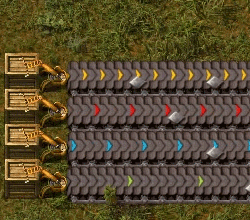
There are 3 different tiers of belts available for use. The transport belt has a yellow color and is the slowest, as well as the cheapest to craft. The next tier up, the fast transport belt has a red color and is twice as fast as the standard transport belt. The express transport belt is the final tier. It is colored blue and is three times faster than normal belts, or 1.5× faster than red belts.
ベルト機構
ベルトの合流・分岐
Belts of all tiers have 2 lanes for items to ride on. This allows for either a double flow of one material, or to transport two different materials on the same belt. Mixed belts can be beneficial for smelting ore, or producing items with many different ingredients such as high tech science pack. The belt can be unmerged using a splitter filter. It is also possible to unmerge a mixed belt by using underground belts since an underground belt will block half of the belt.
Commonly, merging and un-merging is done by using a splitter. The trick in the second gif is better described in the Underground Belt section.
レーンバランシング
Due to how items are placed onto belts by inserters, their lanes can sometimes become unbalanced. In order to maintain throughput, balancing the lanes may be necessary. The gifs below show two ways how to do this. The former only works if only one lane is in use initially. For further explanation of the mechanics, see Balancer mechanics#Lane_balancers.
ベルトスループット
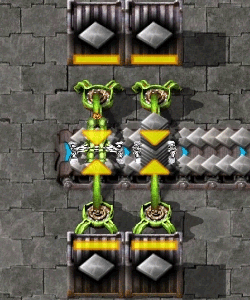
Maximizing the throughput is important since it will keep belts efficient. Therefore some definitions need to be introduced:
- Speed
- How fast a belt moves.
- Density
- How tight are the items put onto the belts.
- Throughput
- This is speed × density. It describes how many items pass by at a given time.
So, there are three opportunities to enhance the throughput:
- More density
- Sometimes items have small gaps in between each other that aren't big enough for other items to fit in. However, mining drills, inserters, and belt sideloading can still force an item into these gaps, temporarily squashing the items on the belt. The squashed gap is extended to normal size once the front of the belt starts to move again.
- More speed
- If the belts in the factory are already at maximum density, their speed can still be upgraded with better belts. Finding the bottleneck is the first thing that needs to be done, usually it can be discovered quite easily. There will be a part of the belt where the items don't move quickly (or at all) or stop at maximum density and suddenly they come to a point where this 'stop and go' effect releases itself, the bottleneck has been found. In most cases, this will be the place where belt optimization is needed.
- More belts
- Adding additional parallel belts can also increase the throughput. Simply place more belts carrying the item that needs throughput.
ベルト便利ワザ
Moving fast can be essential to defend alien attacks in time. Running on a belt will increase or decrease the movement speed of the player accordingly to the belts speed. That is why building a belt towards your defenses can be beneficial.
However, the player is not the only unit that can be moved by transport belts. Additionally, biters and spitters can be moved. This can be abused to improve your defense. Firstly, biters will have a harder time to reach your walls when placing express transport belt in front of them. Secondly, spitters can be moved closer to your walls. That way more turrets can attack a single spitter at once.
Another useful usage is cars on transport belts. Cars have an inventory and can be filled by inserters. So, they can be used as moving boxes on belts. This has several advantages: Firstly the throughput of the belt-car-boxes is amazingly high, secondly the inserter stack size bonus does apply here and makes inserters more effective.
分配器(Splitter)
Splitters are another form of item manipulation. Splitters are a 2×1 entity that splits incoming items on belts from up to two input to up to two outputs, in a 1:1 ratio. They are used to divide resources between two belts, or balance multiple belts.
機構
The behavior of splitters looks simple at first glance. But they are not that simple. Splitters have an astonishing amount of uses.
- Splitters have two input belts and two output belts. If the splitter receives items on one belt, it will split the input evenly between its two outputs.
- If one of the outputs is fully backed-up and the splitter cannot split evenly, it will put all input on its other output.
- Splitters can also take two inputs and one output.
- Splitters preserve the lanes of the items, an item on the right lane is not moved to the left lane and vice versa.
- Splitters can prioritize one input and/or one output. Clicking on a splitter opens its GUI where the priorities can be set.
- One output of the splitter can be filtered to one item. Items of that type will only go to that output, and not to the other one. When a filter is set, the output of that side is prioritized.
In order to join/split belts, the splitter must be the same speed as the incoming belts, otherwise the splitter will become a bottleneck.
優先度
For both the input and output side of the splitter it is possible to set the priority to either left or right.
A splitter where the input priority has been set will first try to consume the specified input side, and will only consume the other input once there is a gap on the prioritized input belt.
Similarly a splitter where the output priority has been set will try to redirect all incoming items to the specified output, and will only output on the other output once the specified output is full.
フィルター
If a specific item is set in the splitter's filter slot, the slider for the output priority will be used for the filter instead. All items of the set type will be redirected to that specific output and all other items are directed to the other output. The input priority can be set independently of the filter.
バランシング
- Main article: Balancer mechanics
Balancers are used to evenly distribute items over multiple belts or multiple belt lanes.
ベルトレーン操作
地下ベルト(Underground belt)
Underground belts can be used to cross different flows of items without interfering. They move items like a normal belt.
- Underground belts can cross any number of entities and all types of ground, like water and grass. (as long as the input and output endpoints are on land)
- Underground belts can cross other underground entities (any number of underground belts or underground pipes). They won't be mixed.
- For the connection only the endpoints (entry-side and exit-side) are relevant.
- The maximum distance underground is 8 tiles with express underground belts.
- An underground belt pair of that bridges a gap of 4 tiles stores up to 44 items. An express underground belt pair at max length stores up to 72 items.
- The half of the underground belt tile with a belt can accept input from the side. The other half (with a tunnel entrance) blocks incoming items.
